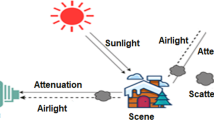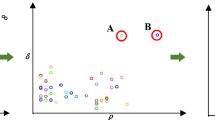Abstract
In the field of digital image and computer vision, haze and smoke removal (dehazing) is one pf a popular scientific arena where it is being studied by an ample number of computer scientists. However, conventional joint dehazing and noise removal techniques use traditional hand-crafted approaches in order to achieve clean image by apply suitable restoration processes. In this study, a smoke removal technique, which designed according to dark channel, prior DCP is proposed. Theoretically, traditional DCP utilized the atmospheric light in the entire image as a global constant and as a result, in our study, the suggested DCP is further enhanced by using filter of second-generation wavelets (SGWs) and therefore, more powerful model is achieved. Consequently, the SGWs filtering is utilized due to its strength in custom designing for complex domains and irregular sampling in order to improve the solution of atmospheric light. The proposed algorithm is evaluated against several state of the art smoke removal methods. Extensive experimentation on multiple datasets demonstrates that our method exhibits better dehazing performance and generalizability than other image dehazing approaches in terms of peak signal-to-noise ratio PSNR, the structural similarity index SSIM and the average gradient results. Moreover, the execution efficiency of the proposed algorithm can reduce considerably the processing time in comparison with the state-of-the-art- smoke removal techniques.








Similar content being viewed by others
Explore related subjects
Discover the latest articles and news from researchers in related subjects, suggested using machine learning.Data availability
All data generated or analyzed during this study are included in this published article.
References
Ali U, Choi J, Min K, Choi Y-K, Mahmood MT. Boundary-constrained robust regularization for single image dehazing. Pattern Recogn. 2023;140: 109522.
Ge Z, Liu S, Wang F, et al. Yolox: Exceeding yolo series in 2021. arXiv 474 preprint arXiv:2107.08430, 2021; 475.
Zhang, H, Patel, V.M.,. Densely connected pyramid dehazing network, in: Proceedings of the IEEE Conference on Computer Vision and Pattern Recognition, 2018; pp. 3194–3203.
Goodfellow I, Pouget-Abadie J, Mirza M, et al. Generative adversarial networks. Commun ACM. 2020;63(11):139–44.
Hu X, Zhou Y. Insulator defect detection in power inspection image using focal 483 loss based on YOLO v4[C]//International Conference on Artificial Intelligence, 484 Virtual Reality, and Visualization (AIVRV 2021). SPIE, 12153: 2021; pp .90–95.
Engelmann J, Lessmann S. Conditional Wasserstein GAN-based oversampling of 462 tabular data for imbalanced learning. Expert Syst Appl. 2021;463(174):114582. https://doi.org/10.1016/j.eswa.2021.114582.464.
Khosla P, Teterwak P, Wang C, Sarna A, Tian Y, Isola P, Maschinot A, Liu C, Krishnan D. Supervised contrastive learning. In: Larochelle H, Ranzato M, Hadsell R, Balcan MF, Lin H (Eds.), Advances in neural information processing systems. 2020; pp. 18661–18673
Wang T, Isola, P. Understanding contrastive representation learning through alignment and uniformity on the hypersphere, In: International Conference on Machine Learning, PMLR. 2020; pp. 9929– 9939.
Henaff, O. Data-efficient image recognition with contrastive predictive coding. In: International Conference on Machine Learning, PMLR. 2020; pp. 4182–4192.
Chen WT, Lou HL, Fang HY, Chen IH, Chen YW, Ding JJ, Kuo SY. DesmokeNet: a two-stage smoke removal pipeline based on self-attentive feature consensus and multi-level contrastive regularization. IEEE Trans Circuits Syst Video Technol. 2021. https://doi.org/10.1109/TCSVT.2021.3106198.
Wu H, Qu Y, Lin S, Zhou J, Qiao R, Zhang Z, Xie Y, Ma L. Contrastive learning for compact single image dehazing. In: Proceedings of the IEEE Conference on Computer Vision and Pattern Recognition, 2021b; pp. 10551–10560.
Iwamoto Y, Hashimoto N, Chen YW. Real-time haze removal using normalized pixel-wise dark-channel prior and robust atmospheric-light estimation. Appl Sci. 2020;10(3):1165.
Jiang N, Hu K, Zhang T, Chen W, Xu Y, Zhao T. Deep hybrid model for single image dehazing and detail refinement. Pattern Recogn. 2023;136: 109227.
Kim K, Kim S, Kim KS. Effective image enhancement techniques for fog-affected indoor and outdoor images. IET Image Proc. 2018;12:465–71.
Khmag A. Smoke removal technique of industrial scene images based on second-generation wavelets and dark channel prior model. Soft Comput. 2023;27(23):17505–14.
Sun H, Li B, Dan Z, Hu W, Du B, Yang W, Wan J. Multi-level feature interaction and efficient non-local information enhanced channel attention for image dehazing. Neural Netw. 2023;163:10–27.
Khan H, Sharif M, Bibi N, Usman M, Haider SA, Zainab S, Shah JH, Bashir Y, Muhammad N. Localization of radiance transformation for image dehazing in wavelet domain. Neurocomputing. 2020. https://doi.org/10.1016/j.neucom.2019.10.005.
Khmag A, Al-Haddad S, Kalantar B, et al. Single image dehazing using second-generation wavelet transforms and the mean vector l2-norm. Vis Comput. 2018;34:675–88.
Khmag A. Additive Gaussian noise removal based on generative adversarial network model and semi-soft thresholding approach. Multim Tools Appl. 2023;82(5):7757–77.
Huang Z, Wang J, Fu X, et al. DC-SPP-YOLO: dense connection and spatial 488 pyramid pooling based YOLO for object detection. Inf Sci. 2020;489(522):241–58.
Chai X, Zhou J, Zhou H, et al. PDD-GAN: Prior-based GAN Network with Decoupling Ability for Single Image Dehazing[C]//Proceedings of the 30th ACM International Conference on Multimedia. 2022: 5952–5960.
Lu ZW, Long BY, Yang SQ. Saturation based iterative approach for single image dehazing. IEEE Signal Process Lett. 2020;27:665–9.
Yang Y, Wang ZW. Haze removal: push DCP at the edge. IEEE Signal Process Lett. 2020;27:1405–9.
Chaturvedi SS, Zhang L, Yuan X. “Pay Attention” to adverse weather: 501 weather-aware attention-based object detection[C]//2022 26th International 502 Conference on Pattern Recognition (ICPR). IEEE. 2022; pp. 4573–4579, 503
Rajesh Kumar N, Uday Kumar J. A Spatial mean and median filter for noise removal in digital images. Int J Adv Res Electr, Electron Instrum Eng. 2015;4(1):246–53.
Deka B, Choudhury S. A multiscale detection based adaptive median filter for the removal of salt and pepper noise from highly corrupted images. Int J Signal Process, Image Process Pattern Recogn. 2013;6(2):129–44.
He K, Sun J, Tang X. Single image haze removal using dark channel prior. IEEE Trans Pattern Anal Mach Intell. 2010;33:2341–53.
Safna Asiq M, Sam Emmanuel W. ‘Colour filter array demosaicking: a brief survey.’ Imaging Sci J. 2018;66(8):502–12.
Wang J, Xu C, Yang W, et al. A normalized gaussian wasserstein distance for 481 tiny object detection. 2021; https://doi.org/10.48550/arXiv.2110.13389.
Khmag A, Al Haddad SAR, Ramlee RA, Kamarudin N, Malallah FL. Natural image noise removal using nonlocal means and hidden Markov models in transform domain. Vis Comput. 2018;34(12):1661–75.
Berman D, Avidan S et al. “Non-local image dehazing,” In: CVPR, 2016;
Zhao X “Single Image dehazing using bounded channel difference prior,” In: Proc. 2021 IEEE/CVF Conference on Computer Vision and Pattern Recognition Workshops (CVPRW), 2021.
Li Z, Shu HY, Zheng CB. Multi-scale single image Dehazing using Laplacian and Gaussian pyramids. IEEE Trans Image Process. 2021;30:9270–9.
Wang Z, Bovik AC, Sheikh HR, Simoncelli EP. Image quality assessment: from error visibility to structural similarity. IEEE Trans Image Process. 2014;13(4):600–12.
. Ancuti CO, Ancuti C, Timofte R, De Vleeschouwer C. ªO-haze: a dehazing benchmark with real hazy and haze-free outdoor images, In: CVPR, 2018.
Author information
Authors and Affiliations
Corresponding author
Ethics declarations
Conflict of Interest
The author declares that he has no conflict of interest.
Additional information
Publisher's Note
Springer Nature remains neutral with regard to jurisdictional claims in published maps and institutional affiliations.
Rights and permissions
Springer Nature or its licensor (e.g. a society or other partner) holds exclusive rights to this article under a publishing agreement with the author(s) or other rightsholder(s); author self-archiving of the accepted manuscript version of this article is solely governed by the terms of such publishing agreement and applicable law.
About this article
Cite this article
Khmag, A. Smoke Removal Method of Industrial Images Based on Dark Channel Prior Approach and Second-Generation Wavelets. SN COMPUT. SCI. 5, 843 (2024). https://doi.org/10.1007/s42979-024-03217-1
Received:
Accepted:
Published:
DOI: https://doi.org/10.1007/s42979-024-03217-1




